插槽
一直对插槽不理解,今天学习,并整理一下,希望日后可以灵活运用。
(一)插槽内容
先简单来个例子,看一下插槽的租作用。
1.1 不使用插槽
父组件中:
<div id="app"> <h1>这是父组件:{{msg}}</h1> <child-component>你好</child-component> </div>
子组件中:
<div> <h2>这是子组件,Child-Component</h2> </div>
结果:
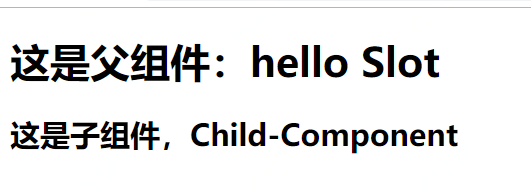
结论:
父组件引用子组件时,在子组件内写入:如(你好或者html),都不会显示。
1.2 使用插槽
父组件中:
<div id="app">
<h1>这是父组件:{{msg}}</h1>
<child-component>你好</child-component>
</div>
子组件中:
<div>
<h2>这是子组件,Child-Component</h2>
<slot></slot>
</div>
结果:
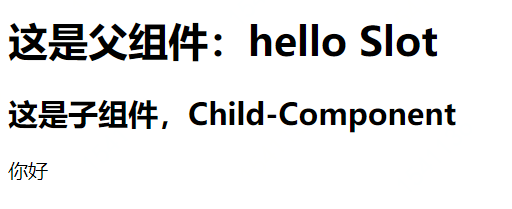
结论:
Vue 实现了一套内容分发的 API,这套 API 的设计灵感源自 Web Components 规范草案,将 <slot>元素作为承载分发内容的出口。当组件渲染的时候,<slot></slot> 将会被替换为“你好”。插槽内可以包含任何模板代码,包括 HTML
1.3 包含html
父组件:
<div id="app"> <h1>这是父组件:{{msg}}</h1> <child-component> <span>slot 测试</span> </child-component> </div>
1.4 如果子组件没有<slot>
如果子组件中没有任何的<slot>,那么在父组件中引用子组件时,在子组件的起始标签和结束标签之间的任何内容都会被抛弃。
(二)后备内容
后备内容,即为没有为插槽设置任何内容时,显示的默认内容。
父组件:
没有为插槽设置任何内容
<div id="app"> <h1>这是父组件:{{msg}}</h1> <child-component></child-component> </div>
子组件:
在子组件中,添加后备内容
<div> <h2>这是子组件,Child-Component</h2> <slot> <span>这是后备内容</span> </slot> </div>
结果:
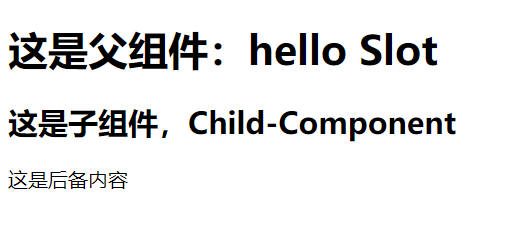
但是如果设置插槽,后备内容则不会显示。
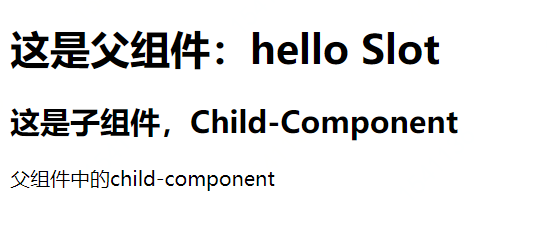
(三)具名插槽
有的时候,我们需要多个插槽,例如:
父子件:
<div id="app"> <h1 style="text-align: center">这是父组件:{{msg}}</h1> <child-component> <template v-slot:header> <h3 style="text-align: center;color: blue">这是header部分</h3> </template> <p style="color: blueviolet;text-align: center">这是主题部分</p> <template v-slot:fooder> <h3 style="text-align: center;color: aqua">这是fooder部分</h3> </template> </child-component> </div>
子组件:
<div> <h2 style="text-align: center">这是子组件,Child-Component</h2> <slot name="header"></slot> <slot></slot> <slot name="footer"></slot> </div>
(四)作用域插槽
父组件中插槽中,可以取到子组件中数据。
父组件:
在v-slot添加元素上的特性被称为插槽 prop
<div id="app"> <h2 >这是父组件!</h2> <child-slot> <template v-slot:default="user"> <p>父组件中,取子组件中的值:{{user.user.lastName}}</p> </template> </child-slot> </div>
子组件:
在<slot>中,绑定数据v-bind:user="user"
<div> <h2>这是子组件</h2> <span>FirstName:{{user.firstName}},LastName:{{user.lastName}}</span> <slot v-bind:user="user">{{user.lastName}}</slot> </div>
结果:
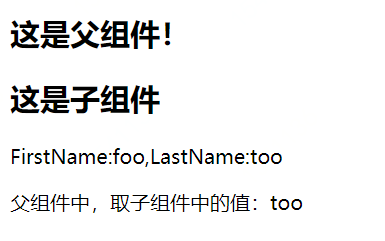
(五)独占默认插槽的缩写语法
当子组件中,只提供默认插槽时,组件的标签才可以被当作插槽的模板来使用。这样我们就可以把 v-slot 直接用在组件上:
<child-slot> <template v-slot:default="user"> <p>父组件中,取子组件中的值:{{user.user.lastName}}</p> </template> </child-slot>
也可以,简写为:
<child-slot> <template v-slot="user"> <p>父组件中,取子组件中的值:{{user.user.lastName}}</p> </template> </child-slot>